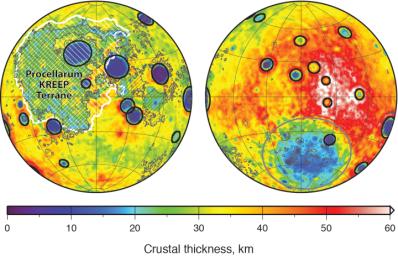
|
Moon Crustal Thickness
- Click the image above for a larger view
- Full-Res JPEG (1557 x 1001) (288.0 kB)
- Full-Res TIFF (1557 x 1001) (4.7 MB)
Caption:
Global map of crustal thickness of the moon derived from gravity data obtained by NASA's GRAIL spacecraft. The lunar near side is represented on the left hemisphere. The far side is represented in the right hemisphere.
In the left hemisphere, outlined in white, is the Procellarum KREEP Terrane, a large province on the near side of the moon which contains high abundances of potassium, rare earth elements and phosphorus. Excluding the Aitken basin at the south pole (the gray circle on the lower half of the far side hemisphere), there are 12 impact basins with crustal thinning that have diameters greater than 124 miles (200 kilometers) on each hemisphere. Those are marked with black circles. The image is presented in two hemispherical Lambert azimuthal equal-area projections centered over the near side (left), and far side (right) hemispheres.
Background Info:
NASA's Jet Propulsion Laboratory in Pasadena, Calif., manages the GRAIL mission for NASA's Science Mission Directorate in Washington. The Massachusetts Institute of Technology, Cambridge, is home to the mission's principal investigator, Maria Zuber. GRAIL is part of the Discovery Program managed at NASA's Marshall Space Flight Center in Huntsville, Ala. Lockheed Martin Space Systems in Denver built the spacecraft. The California Institute of Technology in Pasadena manages JPL for NASA.
For more information about GRAIL, please visit http://grail.nasa.gov .
Cataloging Keywords:
| Name | Value | Additional Values |
|---|---|---|
| Target | Moon | |
| System | Earth | |
| Target Type | Satellite | |
| Mission | GRAIL | |
| Instrument Host | GRAIL | |
| Host Type | ||
| Instrument | ||
| Detector | ||
| Extra Keywords | Color, Impact, Map | |
| Acquisition Date | ||
| Release Date | 2013-11-08 | |
| Date in Caption | ||
| Image Credit | NASA/JPL-Caltech/S. Miljkovic | |
| Source | photojournal.jpl.nasa.gov/catalog/PIA17674 | |
| Identifier | PIA17674 | |
